How to Make Fresh Homemade Ciabatta Bread
This post may contain affiliate links. Please read my disclosure policy.
This post will teach you how to make a crusty, open-crumbed loaf of ciabatta bread. Below you will find a detailed guide full of tips and tricks as well as a troubleshooting section with answers to FAQs to help you make a loaf of ciabatta bread with a crisp, golden exterior, and a light, airy crumb. Video guidance, too!

Friends, today I have a saga to share with you, one that fortunately ends happily: with a crusty, open-crumbed loaf of ciabatta bread, the recipe for which I hope you make soon and then all summer long, for beach lunches and mountain hikes, for dinner with friends and family, perhaps beside a fire or under twinkling bulbs strung from tree to tree, a pool of olive oil at the ready to dunk into at will. This has become one of my favorite homemade bread recipes.
Grab a cup of tea, let’s start from the top …
After posting this sourdough ciabatta bread recipe in April, I felt determined to make a comparable, yeast-leavened variation. For reasons I cannot explain, when I revisited a recipe I had posted here years ago, the photos for which looked promising, I couldn’t get it to work quite as well. The rolls, while tasty, had a tight, closed crumb, not as light or as open as I remembered (or as pictured).
In search of that more wild, amorphous crumb, which ciabatta is known for, I turned to my various bread baking books, namely The Bread Baker’s Apprentice, which noted that ciabatta often is made with a poolish or biga, meaning a small amount of flour and water mixed with a leavening agent and left to ferment for a short period of time.
This got me thinking: could I replace the 100 grams of sourdough starter in the sourdough ciabatta recipe with 100 grams of poolish? I gave it a go, stirring together 50 grams each flour and water with 1/2 teaspoon instant yeast and then letting it sit for three hours. When the surface of the poolish was dimpled with holes, I proceeded with the recipe, adding water, salt, and flour; mixing the dough; stretching and folding it; letting it rise, and finally transferring it to the fridge overnight.
The following morning, I turned the dough out onto a floured work surface, cut it into eight portions, and transferred them to a sheet pan. One hour later, I baked them.
Friends! It worked beautifully. The crumb, while not quite as honeycombed as the sourdough version, was full of holes, giving the ciabatta its characteristic lightness and airiness. I felt really good about the recipe — it was simple enough, nearly identical to the sourdough version without having to use a sourdough starter, and very tasty.
I almost posted the recipe but anticipating that some people might want a loaf of ciabatta as opposed to rolls, I decided to test the recipe in loaf form.
This is where the saga begins. The two loaves I pulled from the oven, while crusty and beautiful from the exterior, were … HOLLOW! I had baked, in essence, two gigantic pita breads, perfect for housing torpedo-sized falafel. (Stay tuned … the saga continues! Kidding.)
This experience sent me on a tear to figure out where I went wrong. As I read about “tunneling”, I tried many things to fix the situation — lowering the hydration, increasing the hydration, kneading the dough, lowering the oven temperature, decreasing the amount of yeast, eliminating the cold proof — and in the process, I made many many loaves of hollow ciabatta. At the risk of sounding a little dramatic, this quest paralyzed me creatively — truly: without this ciabatta puzzle solved, I couldn’t create a single new recipe for the blog.
In the end, after doing a bit more digging, the fix was simple: to lengthen the final proof. Whereas the sourdough ciabatta can rest at room temperature for only an hour before baking; the yeasted ciabatta — at least in loaf form — needs much more time, more like 2 to 2.5 hours.
Why? Because, as I’ve learned, when under-proofed dough enters an oven, the yeast has lots of remaining energy, which leads to fast and furious gas production. This explosion of gas breaks the structure of the bread, causing the tunnel to form.
As soon as I extended that room-temperature proof, the tunnels, thankfully, vanished.
Friends, if I’m being honest, it is not without trepidation that I post this recipe. As I type, I have two bowls of ciabatta dough rising — just to be sure! I have made more ciabatta these past two months than any other bread I think ever (with the exception, of course, of my mother’s peasant bread), and though I am now consistently met with great results — with loaves that emerge from the oven flour-dusted, golden-crusted with both a chewy and light, porous texture — I still worry. Those hollow loaves haunt me.
As you can see, I’m a bit anxious for you all to give this recipe a try. My wish, as noted at the start, is for this to become your summer dinner bread, your trusty swiper for all those delicious, oily, corn-studded, tomato-infused, basil-specked dregs. They deserve it.
If you give it a go, please let me know how it turns out.
PS: Foolproof Pita Bread Recipe
PPS: Overnight Refrigerator Focaccia = The Best Focaccia
Traditional Ciabatta: An Overview
Let’s review what ciabatta is:
- Traditional ciabatta is characterized by a slipper shape as well as an extremely porous and chewy texture. Originating from the Lake Como region of northern Italy, ciabatta means “slipper” in Italian.
- Ciabatta dough is wet and sticky with hydration levels often 80% or higher. Both the recipe below and this sourdough version are 82% hydration. (If you are unfamiliar: To calculate hydration percentage, simply divide the weight of the water by the weight of the flour; then multiply it by 100. In this recipe, that’s 410/500=0.82 | 0.82 x 100 = 82%)
- Traditional ciabatta recipes call for very little yeast and a long, slow rise. Many recipes call for making a biga or poolish (as noted above), which helps produce that light, airy texture.
- Some ciabatta recipes call for milk or olive oil, but neither of these ingredients is required to make a traditional loaf of ciabatta.
And let’s review what ciabatta isn’t:
- Shaped! In the ciabatta bread recipe in Jeffrey Hamelman’s Bread, he notes: “There is no preshaping or final shaping—once divided, the dough is simply placed onto a floured work surface for its final proofing.” With the sourdough ciabatta bread recipe, I follow this no-shaping rule. In this yeasted recipe, I deviate! After a number of experiments, I prefer doing a pre-shape — it’s counterintuitive but I actually get a more open crumb when I preshape the dough. That said, for ciabatta rolls, I stick to the no-shaping rule — it’s nice not having to ball up 8 portions of dough. (Of course, you can experiment and see which method you like best.)
- Scored! Unlike other crusty loaves of bread, ciabatta is not scored.
Troubleshooting
If your dough does not cooperate the first time around, you may need to make some changes:
- Water: This is a very high-hydration dough, and depending on the flour you are using and your environment (if you live in a humid environment, for instance), you may need to reduce the amount of water. If, for example, when doing your stretches and folds, the dough never came together in a cohesive ball, I would reduce the water by 50 to 60 grams next time around.
- Flour: All flours absorb water differently. Through troubleshooting with people all over the world often with people making this sourdough pizza recipe, this yeast-leavened pizza recipe, and most recently this sourdough ciabatta recipe, the type of flour being used plays a critical role in how the dough turns out. Often the water needs to be reduced considerably for the dough to come together. If you live abroad or in Canada, you can either make the recipe once as written or add the water slowly, mixing as you do, until the dough resembles the dough in the video.
- Shaping: Because this is such a wet dough, shaping may be tricky. I have smooth, wooden countertops (there’s some sort of sealant on top) that work nicely for shaping, and I imagine granite and marble would work well, too. My mother loves her Roul’ Pat for shaping. All of this is to say, if you are having trouble shaping, the surface you are shaping on could be playing a role.
How to Make Ciabatta Bread, Step by Step
The first step of the recipe calls for making the poolish. To do so, gather your ingredients: flour, water, and instant yeast. SAF is my preference.
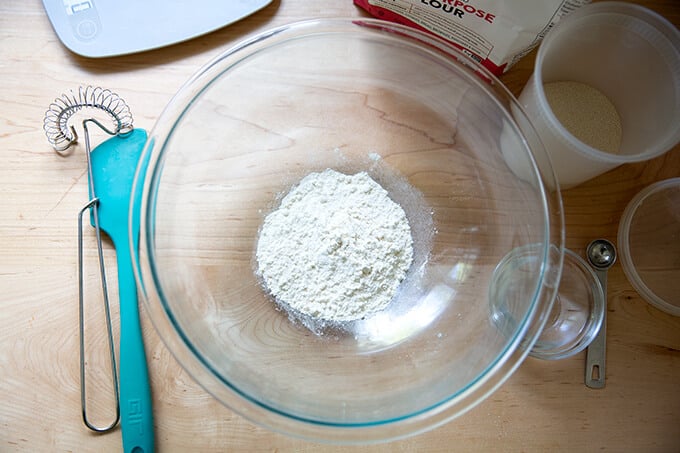
Whisk together 50 grams flour and 1/2 teaspoon instant yeast.
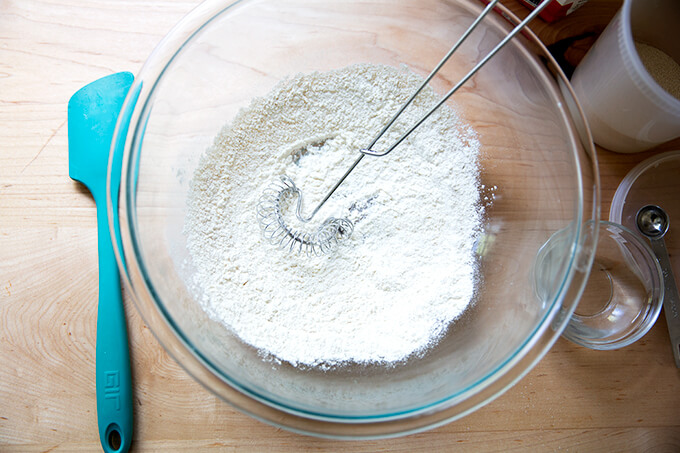
Add 50 grams water.

Stir to combine. Cover the bowl and let sit for 3 to 4 hours or until…

… the surface of the dough is dimpled with air pockets.

Add 360 grams water. (This part is really fun … the poolish bubbles up as a unit and floats on top of the water… it really feels alive!)

Stir to combine; then add 12 grams salt and stir again to combine.
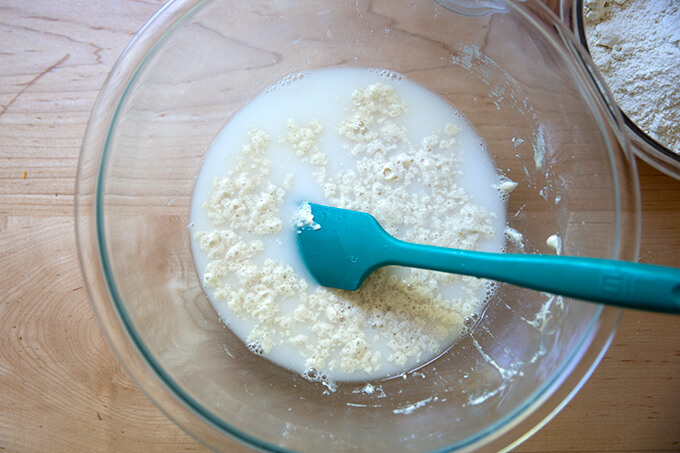
Add 450 grams flour, preferably bread flour.

Using a spatula, stir until you have a sticky dough ball. Cover and set aside for 30 minutes.

With wet hands, perform a set of stretches and folds, by grabbing one side of the dough, and pulling it up and to the center. Rotate the bowl a quarter turn, and repeat the grabbing and pulling. Do this until you’ve made a full circle. (Watch the video for more guidance. I employ a sort of “slap and fold” technique, which is helpful with this very wet dough.) Cover the bowl.

Thirty minutes later, repeat the stretching and folding.

If time permits, repeat this stretching and folding twice more at 30-minute intervals. This is what the dough looks like after the third set of stretches and folds:
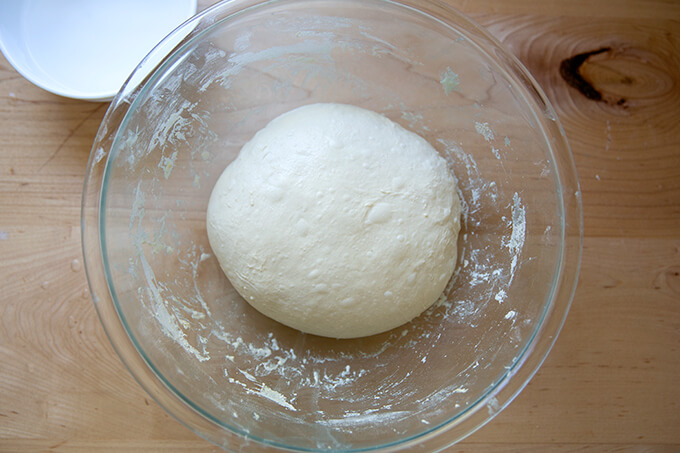
This is what the dough looks like after the 4th set. Feeling the dough transform from a sticky dough ball to a smooth and elastic one is really cool.
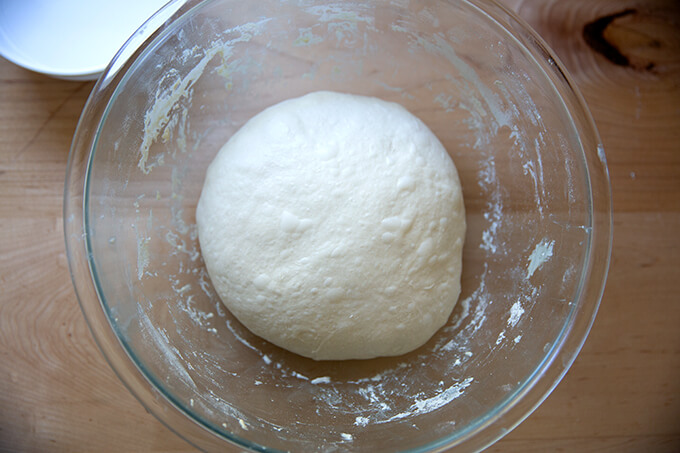
Transfer the dough to a straight-sided vessel and let it rise at room temperature until…

… it doubles in volume. (Note: If you don’t have a straight-sided vessel, you can simply let the dough rise in a bowl. I personally like using a straight-sided vessel because it allows me to see when the dough has truly doubled in volume.)
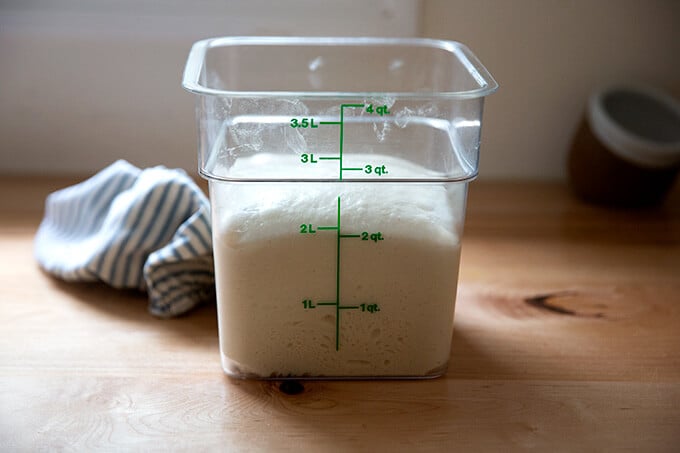
Then, punch down (deflate) the dough — I like to remove the dough from the vessel …
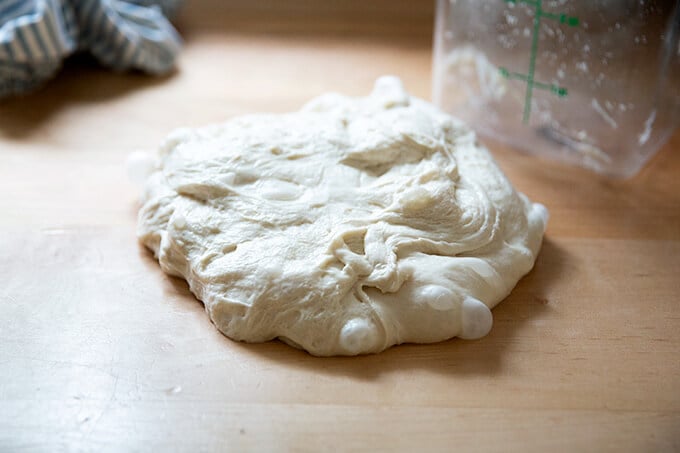
… and ball it up using wet hands.

Return the dough to the vessel; then transfer to the fridge. (Another plus of using the straight-sided vessel is that it’s easier to store in the fridge than a bowl.)
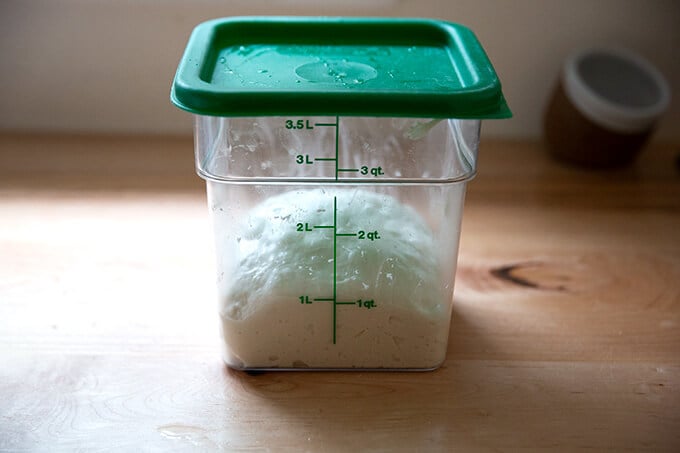
The dough will likely double in volume overnight in the fridge.

Remove the dough, turn it out onto a work surface…

… then ball it up. (Note: This is where I deviate from the traditional ciabatta-making method. If I were to follow the traditional path, I would have simply patted that blob of dough pictured above into a rectangle; the cut it in half. I find I get a more open crumb when I preshape the dough.)

Divide the dough into two equal portions. Ball up each portion. I like to do this with very little or no flour — I find I get better tension with less flour.

Sprinkle a work surface liberally with flour. Place the balls top-side down (the smooth side); then sprinkle the balls liberally with flour. Cover with a tea towel and let rest for 2.5 hours. Line a sheet pan with parchment paper.
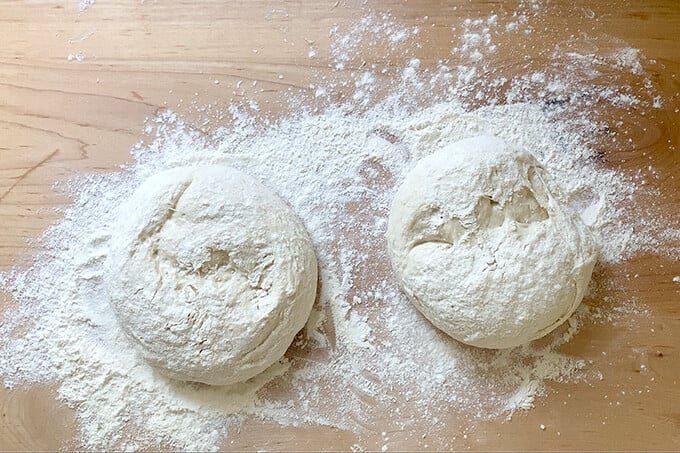
After the 2.5 hours… the dough balls will look like this:
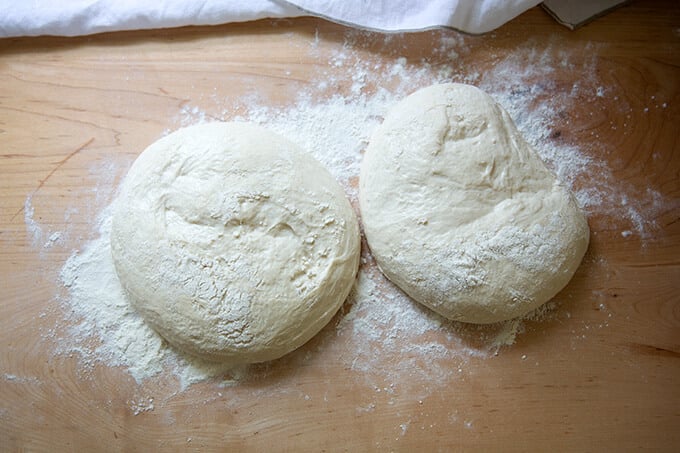
Turn the balls back over…
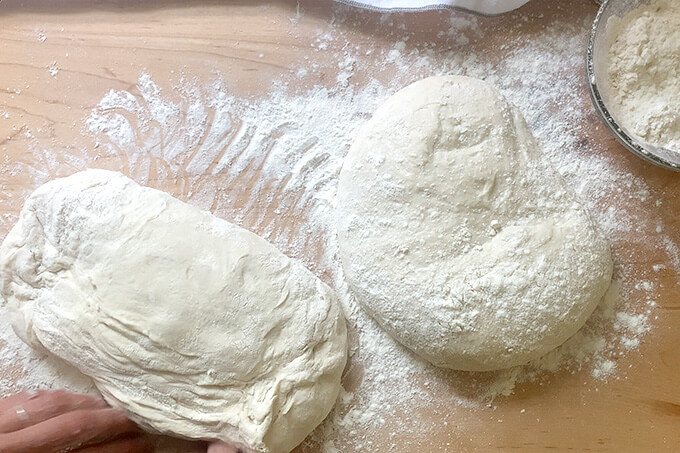
… then carefully transfer them to a parchment lined sheet pan.

Bake at 425ºF for 20-25 minutes or until nicely golden:

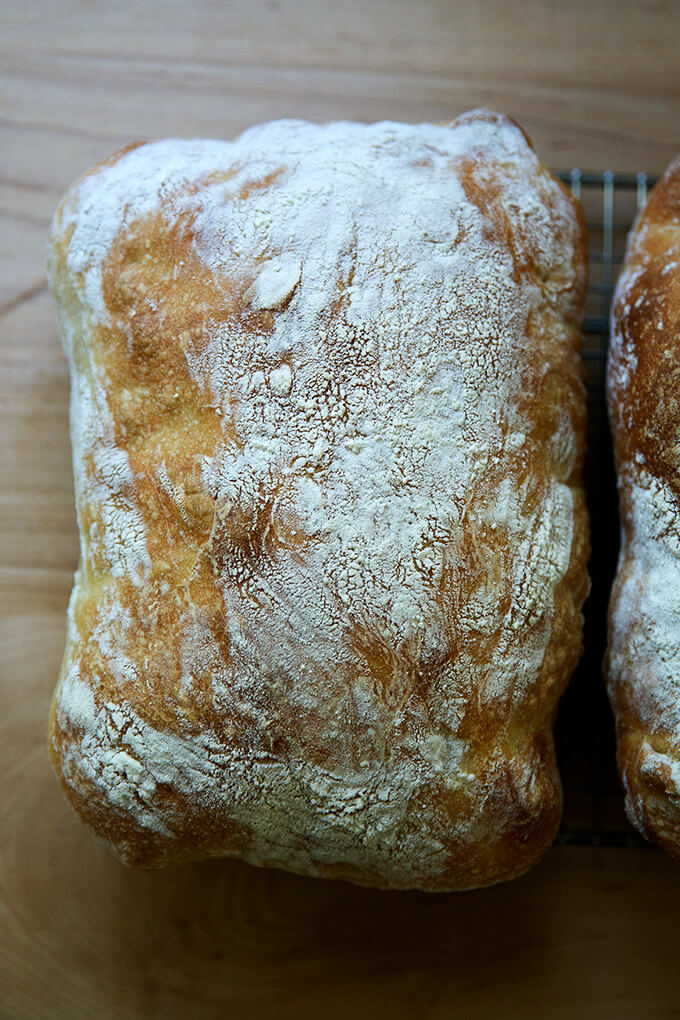
Let cool at least 20 minutes before slicing.


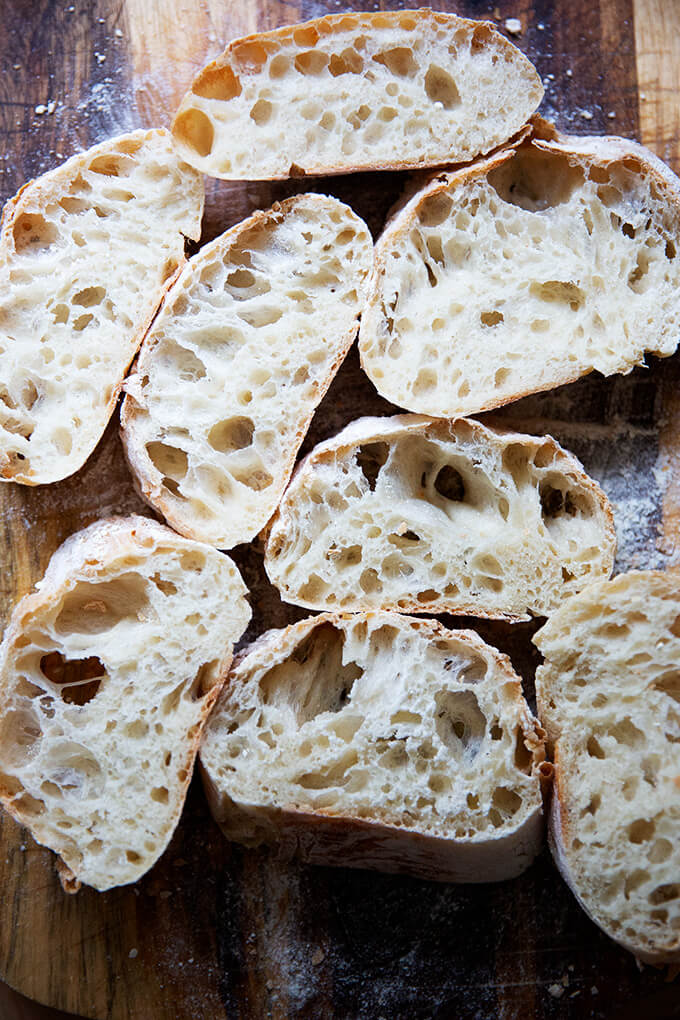

How to Make Ciabatta Rolls
Follow the recipe as outlined above or in the recipe box below until the step in which you remove the dough from the refrigerator; then, sprinkle a work surface with flour. Turn the dough out, sprinkle the surface with more flour, and pat it into a rectangle. (Note: This method, unlike above, follows a traditional ciabatta method — there’s no preshape or final shape. I prefer doing this with rolls for simplicity. It’s nice not having to ball up 8 portions of dough. If you wish, of course, you can ball up each round of dough.)
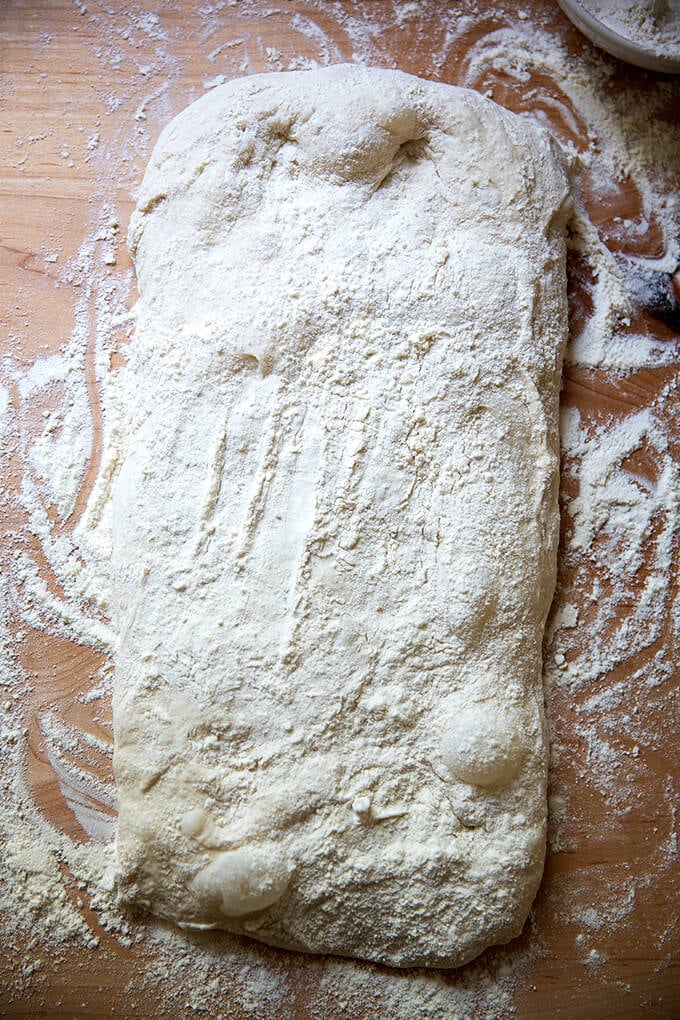
Divide into 8 portions.
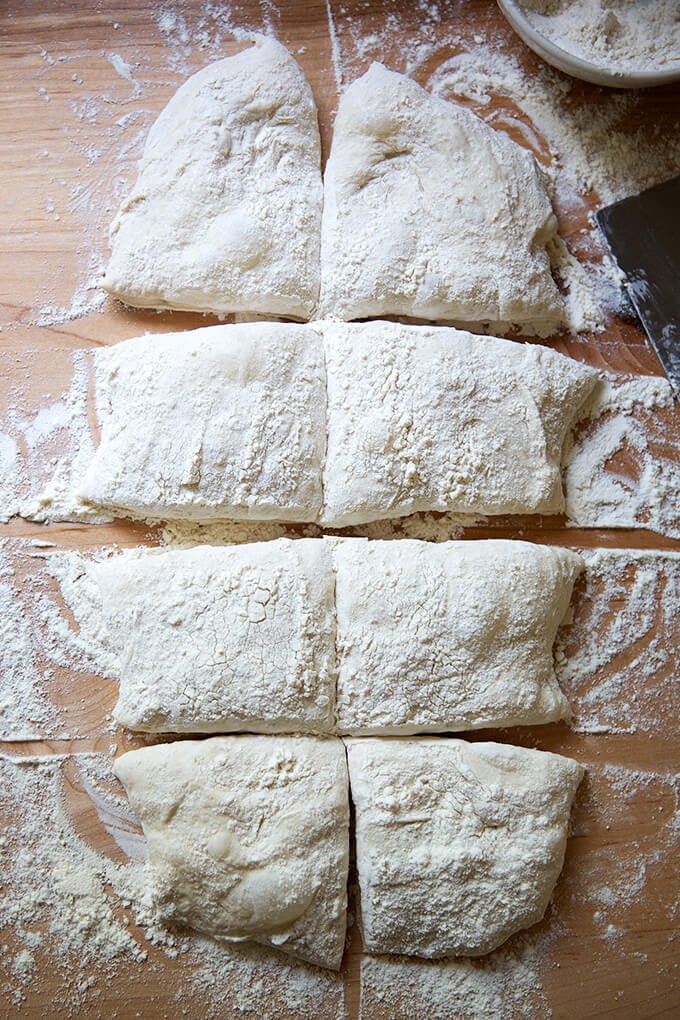
Transfer to a sheet pan, cover with a tea towel, and let stand for 2 to 2.5 hours.

Transfer the pan to the oven, and bake at 425ºF for 20 to 25 minutes.
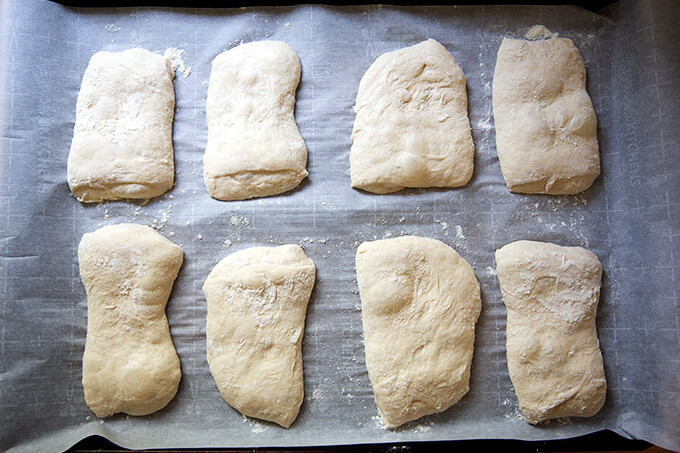
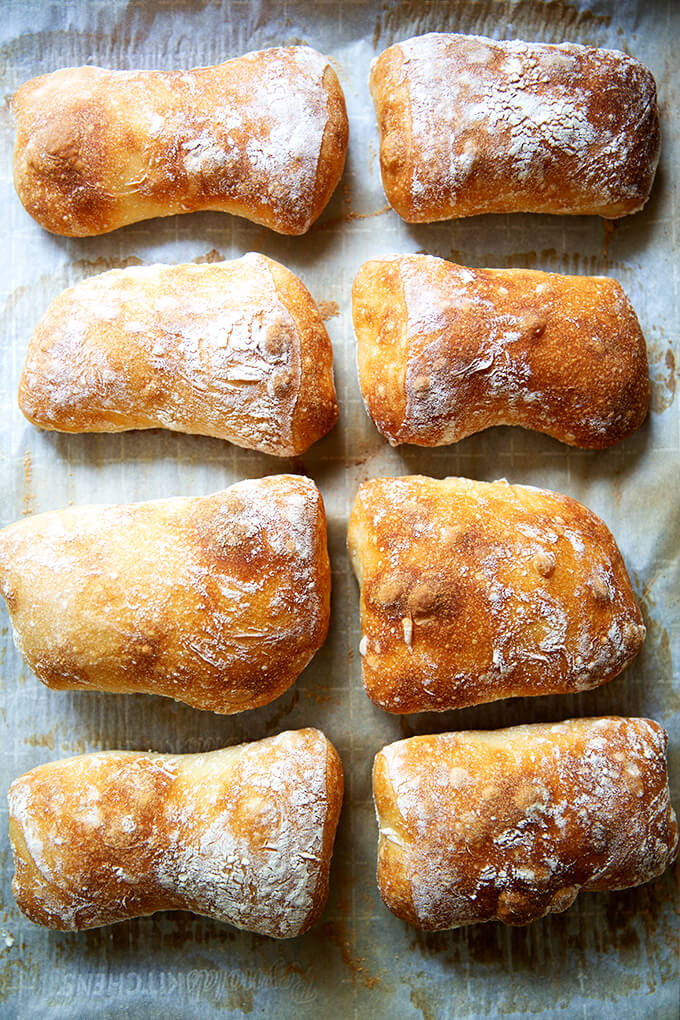
Let cool for at least 20 minutes before halving or slicing.
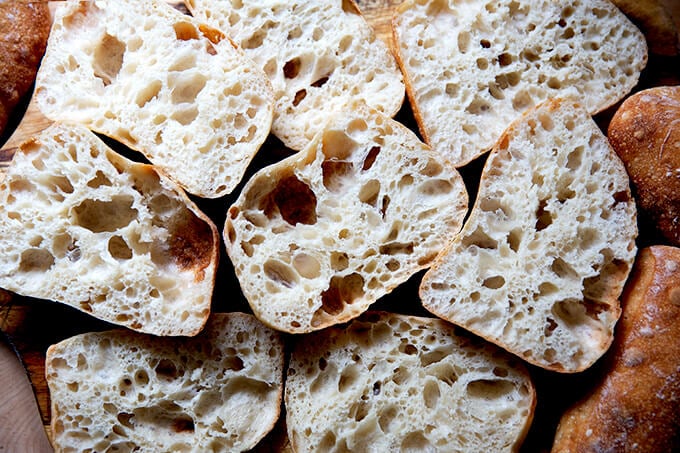
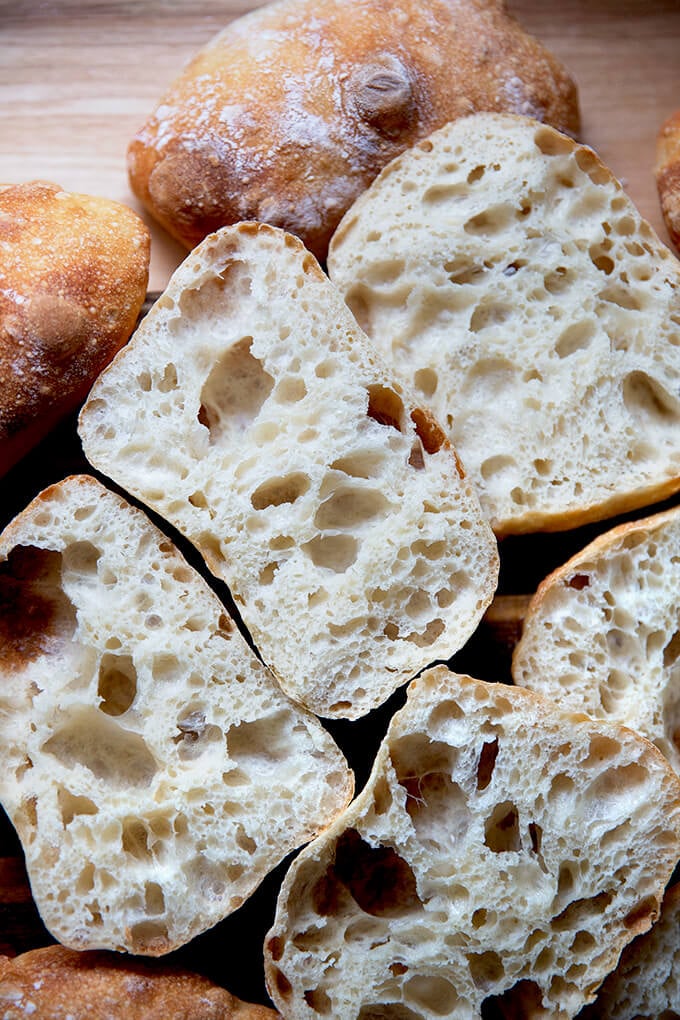
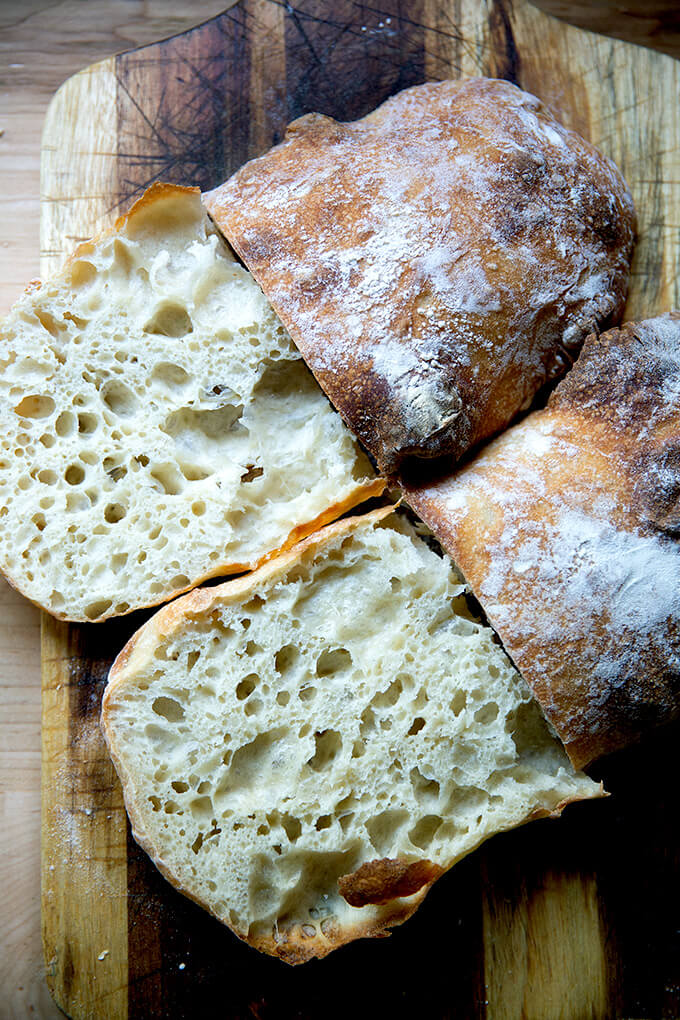

How To Make Fresh Homemade Ciabatta Bread
- Total Time: 24 hours 20 minutes
- Yield: 8 rolls
- Diet: Vegan
Description
This post will teach you how to make a crusty, open-crumbed loaf of ciabatta bread. It calls for making a poolish (a preferment), and it’s a very high hydration dough (82%), which means the dough will be wet and sticky. I highly recommend watching the video before attempting the recipe.
Notes:
- As always, for best results, use a digital scale to measure the flour.
- I have had success using all-purpose flour, but if you can get your hands on bread flour (I use King Arthur Flour Bread Flour, which is 12.7% protein), that is ideal, especially if you live in Canada or abroad. If you live abroad or if you live in a humid climate, this may take a try or two to get right — I suggest making it once as written; then reducing the water by 50 grams or so depending on your results.)
- I find a bench scraper particularly helpful for this recipe.
- I also really love using a straight-sided vessel (with lid) both for letting the dough rise and storing it in the fridge.
Ingredients
For the sponge:
- 50 grams (about 1/3 cup) all-purpose flour
- 2 grams (1/2 teaspoon) instant yeast, SAF is my preference
- 50 grams (about 1/4 cup) water, lukewarm or room temperature
For the ciabatta dough:
- 360 grams (about 1.5 cups) water, lukewarm or room temperature
- 12 grams (about 2 teaspoons) salt, kosher or sea salt
- 450 grams (about 3.5 cups) bread flour, see notes above
Instructions
- Make the poolish: In a large bowl, whisk together the 50 grams flour and the 2 grams (1/2 teaspoon) instant yeast. Add 50 grams water and stir with a spatula until combined. Cover the bowl with a tea towel or cloth bowl cover and set aside for 3 to 4 hours or until the dough’s surface is dimpled with holes.
- Make the dough: To the bowl of the poolish, add the water. The sponge should release from the bowl and parts of it, if not all of it, will float. Add the salt and stir briefly. Add the flour, and stir until you have a wet, sticky dough ball — dough will be very sticky. Cover with a tea towel or cloth bowl cover and let sit for 30 minutes.
- Stretches and folds: With wet hands, grab one side of the dough, and pull up and to the center. Rotate the bowl a quarter turn, and repeat the grabbing and pulling. Do this until you’ve made a full circle. (Watch the video for more guidance. I employ a “slap-and-fold” technique, which is helpful when handling these wet doughs.) Cover the bowl. If time permits, repeat this process three more times at 30-minute intervals for a total of 4 sets of stretches and folds over the course of two hours. If you are short on time, know that doing just one or two sets of stretches and folds is totally fine.
- Let it rise: Transfer the dough to a straight-sided vessel, if you have one, or leave it in the bowl if you don’t. Cover the vessel with a towel and let rise until doubled in volume. Punch down (deflate) the dough — if your dough is still in the bowl, you can deflate it using wet hands right in the bowl; if your dough is in a straight-sided vessel, it may be easier to turn the dough out onto a work surface and ball it up using wet hands to prevent sticking. Return the dough to the vessel, cover it with an airtight lid, and transfer it to the refrigerator immediately for at least 12 hours. The dough can remain in the fridge for as long as 48 hours.
- Portion and shape: (Note: This is where I deviate from traditional ciabatta bread recipes. See notes in the post above for the more traditional shaping method.) Turn the dough out onto a work surface. I prefer to do this step without flour, but absolutely sprinkle your surface lightly with flour as needed to make the dough manageable to work with. Using a bench scraper or your hands, shape the dough into a tight ball; then use the bench scraper to divide the dough in half. If you want perfectly even balls, each portion will way roughly 455 grams. Again, use the bench scraper or your hands to ball up each portion into a tight ball — see video for guidance.
- Proof: Sprinkle your countertop liberally with flour. Place the balls top-side (smooth side) down onto the flour. The seam-side will be on top now, and it may split open — this is fine. Sprinkle the top surface of the balls liberally with flour. Cover with a tea towel and let rest for 2.5 hours. After 2 hours of proofing, heat the oven to 425ºF.
- Line a sheet pan with parchment paper. When the dough has finished proofing, gently flip each ball over — I find a bench scraper to be helpful here. Then use both hands to stretch each ball out gently into a rectangular shaped “slipper”. Transfer to the prepared pan.
- Bake for 20 – 25 minutes or until the loaves are golden all around. Remove pan from oven. Transfer ciabatta rolls to a cooling rack. Let cool for 20 to 30 minutes before slicing.
- Prep Time: 24 hours
- Cook Time: 20 minutes
- Category: Bread
- Method: Yeast
- Cuisine: Italian, American
This post may contain affiliate links. Please read my disclosure policy.













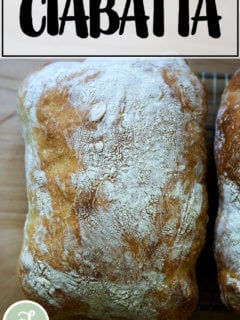

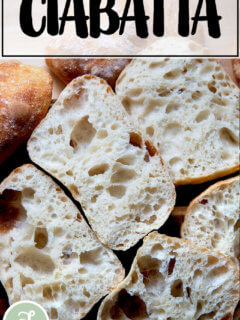
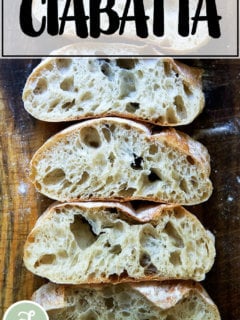
262 Comments on “How to Make Fresh Homemade Ciabatta Bread”
Hello Alexandra
I love the look of your bread but have tried this recipe a few times now and its just soooooo wet i can’t get it into a ball, it’s a bit like porridge what am I doing wrong?
I’ve tried a bit less water but still very sloppy, will it still work if I put 30% less water
Hi Max! Sorry for the trouble you’re having with the dough. Yes: hold back some of the water. I see that you’re in New Zealand, correct? It’s possible the flour you are using absorbs water differently — i.e. doesn’t absorb as much as the flour I am using — which is causing your dough to be wetter. You could try starting with 300 grams water and then adjust from there next time around with more or less.
Hi Max, I’m also in NZ and have just tried this recipe for the first time today. The mix was very wet, but the ciabatta turned out okay, just a little denser than ideal (I will try a little less water next time). Maybe it’s the brand of flour… I used Champion Professional Beta which is a strong bread flour. I’ve found this flour to be significantly better than any strong bread flours you buy at the supermarket. Depending on where you live, you should be able to find it at a trade wholesaler. Hope this helps!
Hello Alexandra.
I tried your recipe.
Everything was done as per the recipe
I kept it in the fridge for more than 12 hours proofing too.
It rose more than double.
I kept it for the final proof for 2 n half hour
The bread is soft chewy and crusty from the outside.. but I did not get air pockets like your bread.
It’s like a normal loaf
Can you help?
Hi! Are you using a scale to measure? And what type of flour are you using?
Thank you for sharing this easy and delectable recipe!
I have baked twice now and each came out amazing! I don’t want to buy bread at stores anymore!
Great to hear, Sona! Thanks so much for writing 🙂 🙂 🙂
I absolutely love this recipe. I cannot decide whether I like this one or the focaccia recipe better … it’s a very tough call. But for serving with soup or a yummy herb butter, this is our go-to.
Great to hear, Wendy! Thanks for writing 🙂
Hi,
Just curious and want to confirm there is NO yeast added to the dough (only to the sponge)? Seems unusual as most recipes for Ciabatta add it to the sponge / poolish AND to the main dough?
Thanks!
Correct!
First time and it was a big success!!!! I was anxious it will be hallow but turned out to look like yours!
I didn’t put it in the fridge overnight though, I forgot that step, just left it in the kitchen for the night. Still turned great! Will prepare these for my home made Christmas baskets. Thank you
Great to hear, Crina! Thanks so much for writing and sharing your notes 🙂
Hey Alexandra! I plan on making this recipe soon, and I was wondering if 1: I could leave it in the fridge overnight for longer than 12 hours, would it hurt at all? and 2: I could use all purpose flour as a substitute for the bread flour? Thank you so much!
Hi Molly! Yes, you can leave it in the fridge for more than 12 hours, and ap flour should be fine, but your dough may be even wetter than what you see in the photos and video here. I might consider holding back 25-50 grams of water.
Thank you so much, I appreciate you taking the time to respond!
It worked so well for me with the first attempt. I used Bob Red Mill’s bread flour and didn’t have any issues. Amazing recipe! I’ll be making it this Saturday for Friendsgiving! What is the max amount of time would you keep the dough refrigerated? I want to make it as far ahead as I can 🙂 thank you a million ❤️❤️❤️
Great to hear! I have not done much more than 24 hours in the fridge, but I have done up to 3 days with other bread doughs (and longer for pizza), so it probably would be fine for more than 24 hours but I haven’t experimented so I’d hate to leave you astray.
Hi. I’m going to be starting this recipe today…actually right now so I can have this bread for our easter dinner. It will be my first attempt making ciabatta and any kind of bread with these techniques. I’m pretty new to bread making but I want to keep pushing myself to make more and more new types. This recipe looks amazing and exactly what I want my ciabtta to look like. Fingers crossed. I will be using active dry yeast instead of instant yeast in my poolish will that make a difference?
The active dry yeast shouldn’t make a difference in the poolish. Good luck Nicole! I hope it turns out well. Happy Easter!
Hi…I went wrong with the water right at the beginning.I don’t have digital scales. 1.5 cups wasn’t enough I added more kind of randomly..ml would have been more useful. I will keep trying..I got good bread rolls, they were edible 😉 I knew I had lost when my bread didn’t double overnight…or when my poolish didn’t go mad…I’ll buy new yeast but could you give the water in ml pls. Thanks x
2nd attempt made fabulous bread but added 1 cup extra of water.
I just baked this bread for the very first time and it came out great! Thanks for sharing your knowledge . Your instructions were clear and very easy to follow. I am just wondering now, what’s the best way to store it?
Great to hear, Cynthia! I’d stick it in a jumbo airtight bag and store it at room temperature for up to 3 days or freeze for up to 3 months. Always reheat before serving on subsequent days.
Thanks for the tip!
Looks like fun to make!! Am doing this week with my son! Is it possible to add kalamata colicee? If so, when do we add them?
Will reduce water next time but still came out great! Very thorough directions for this novice.
Great to hear, Michael 🙂
Is there anything we need to adjust to bake this at high elevation (rocky mountains)?
It should be fine… the long slow rise and high hydration dough should work well at high altitude.
Hi Alexandra.
I really like your recipes. Thanks for sharing them.
I just have a quick question, is it possible to leave the biga out overnight and continue the process the in the morning or it shouldn’t be left out more than 3 hours?
Thanks.
Hi! I think it should be fine overnight. I think you could probably cut the yeast back to 1/4 teaspoon if you do.
Alex, which one of your breads would you “go to” if serving brie with a sweet topping. I have your bread book and often make some of your basic breads and rolls but not sure what would work best for this appetizer. Hopefully something I can cut into 1-2 bite pieces and oven toast lightly. I like the look of the ciabatta but thinking I should use something with a tighter crumb. You have so much experience with bread baking I thought you could point me right. Thank you.
Hi! I actually think focaccia is perfect for what you are describing. Look at the crostini photos in this post: Sun-Dried Tomato and Spinach Pesto with Crostini You don’t have to toast the focaccia for quite as long. The height of focaccia makes it a great width once it becomes crostini.
Alex, great, thank you. What’s funny is I have made that terrific pesto several times and we eat on crackers or italian bread and have even tossed with orzo. I never realized the pictured bread was your focaccia. I see now you mention in your intro. I have made your focaccia, I think I used my lloyd pan, I will check my scribbles on the recipe. I know what I’ll be making the next couple of days….! Onward….
Wonderful to hear, Denise! Your Lloyd pan will be great for the focaccia 🙂
Hello Alexandra!
I’ve been meaning to make this for a while, but my city is currently undergoing a heatwave (average temps higher than 32°C), so I’m wondering if I should reduce the duration of the second proof?
Does the poke test apply here?
Many thanks.
Have a wonderful week,
Nick
That’s a good idea, Nick! And yes, the poke test should help you determine when to end the second proof. Good luck!
Wow, this recipe is fantastic! I’ve made the rolls and a loaf, both turned out great. I don’t often write reviews but felt I felt the need with this recipe. I admittendly was a bit worried my dough was a bit stickier than your videos showed but after making your other bread recipes I kept my fingers crossed and they turned out. Everything was very airy and just as your pictures. The bread was so delicious it was eaten in less than 24 hours. This recipe will be a staple for sure! Thank you!
i love this recipe and have had much success with it!! i’ve made so many ciabatta loaves using this recipe and i love all of your other ones, thank you!!
i was curious, what temperature water do you use for the yeast activation and the dough? i’ve always used water that has a temp of 95-105 degrees… i’m not sure what temperature range lukewarm is.
also, how would one achieve those big holes / the gluten structure you have pictured of your ciabtta? that is my main goal now is to get bread with those holes. i’ve tried not handling the dough too much/pressing down when shaping them before the rise/before baking.
thank you so much
Great to read all of this 🙂
Yes, that is accurate: 95-105 degrees.
Questions: Are you using a scale to measure? What type of flour are you using?
thank you so much for replying !!
i am using a digital scale- ALWAYS 🙂 i cannot without.
i use bob’s red mill bread flour typically. but always always bread flour. i use all purpose flour for the poolish though.
I made this recipe and followed the biga recipe exactly. However, I used 1 cup of whole wheat flour while making the bread (medical reasons). The flavor is really good, but did not get the nooks and crannies like a ciabatta. Loved how easy you made the recipe to follow. Any ideas how to make the whole wheat work?
Hi Pat,
Unfortunately, the down side of using whole wheat flour is that all of the bran present in it cuts through the gluten structure, which makes it harder to create big air pockets which lead to those nooks and crannies. What type of whole wheat flour are you using? Have you ever done an autolyse?
Great recipe and amazing instructions!
I live in Toronto, Canada and used Ardent Mills all purpose flour. It was a “tad” on the gloopy side but still cooked perfectly! I will drop the water by 20g the next time I make it.
Thanks for all your hard work to make it easier for us to bake! 😊
Great to hear, Tina! Thank you for writing and for your kind words. Dropping the water slightly next time sounds like a good idea 🙂 🙂 🙂
YUM! This was my first attempt at ciabatta and it turned out amazing. Now I just have to stop myself from eating it all in one sitting!
Great to hear Kennedy! Thanks for writing 🙂 🙂 🙂
As someone who loves homemade bread but has too many commitment issues to make a sourdough starter, this recipe is my absolute favorite bread recipe! Perfect chewiness and the taste is divine. However, I was wondering, if I wanted to add black olives to the ciabatta, would I have to alter the recipe at all? Do I just work the olives into the dough in the beginning? Do I just plop on olives right before baking? Your bread insight would be greatly appreciated.
Hi Daniel! Great to read all of this. Thank you for writing. I would suggest adding the olives just before the third set of stretches and folds: sprinkle them over the dough, stretch and fold, then let it rest for 30 minutes and repeat. You might want to add a 5th set of stretches and folds to ensure the olives are mixed in evenly.
I may have added too much water during my slap and folds, and I left it in the fridge for about 20 hours, so it was a little flatter after the final rest. It’s still very good though.
Great to hear, Angela! It’s possible given your environment you may want to reduce the water from the start 🙂
Can you leave the poolish overnight?
Yes!
Hi Ali, this recipe was just great. Your tips and advice are so worth following. I am a fan of all your recipes – have tried a bunch and they are all successful. Thanks
Great to hear, Heather! Thanks for writing 🙂